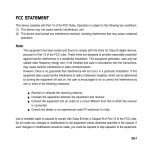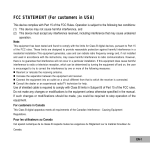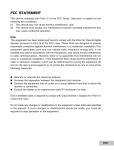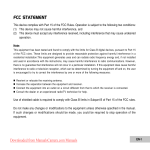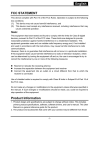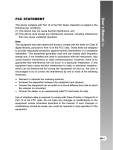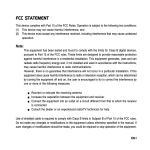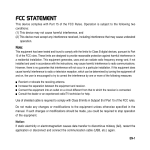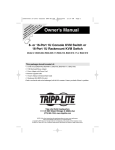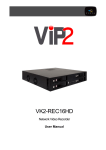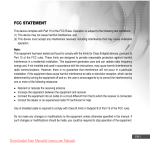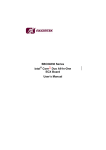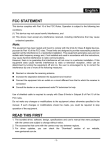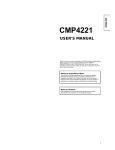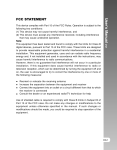Download DS5341-EN-SUPRA
Transcript
This device complies with Part 15 of the FCC Rules. Operation is subject to the following two conditions: (1) This device may not cause harmful interference, and (2) This device must accept any interference received, including interference that may cause undesired operation. Note: This equipment has been tested and found to comply with the limits for Class B digital devices, pursuant to Part 15 of the FCC rules. These limits are designed to provide reasonable protection against harmful interference in a residential installation. This equipment generates uses and can radiate radio frequency energy and, if not installed and used in accordance with the instructions, may cause harmful interference to radio communications. However, there is no guarantee that interference will not occur in a particular installation. If this equipment does cause harmful interference to radio or television reception, which can be determined by turning the equipment off and on, the user is encouraged to try to correct the interference by one or more of the following measures: User’s Manual >> FCC STATEMENT Reorient or relocate the receiving antenna. Increase the separation between the equipment and receiver. Connect the equipment into an outlet on a circuit different from that to which the receiver is connected. Consult the dealer or an experienced radio/TV technician for help. Use of shielded cable is required to comply with Class B limits in Subpart B of Part 15 of the FCC rules. Do not make any changes or modifications to the equipment unless otherwise specified in the manual. If such changes or modifications should be made, you could be required to stop operation of the equipment. EN-1 Digital Camera >> READ THIS FIRST Trademark Information Microsoft ® and Windows ® are U.S. registered trademarks of Microsoft Corporation. Pentium® is a registered trademark of Intel Corporation. Macintosh ® is a trademark of Apple Computer, Inc. SDTM is a trademark. Photo Explorer and Photo Express are trademarks. Other names and products may be trademarks or registered trademarks of their respective owners. Product Information Product design and specifications are subject to change without notice. This includes primary product specifications, software, software drivers, and user’s manual. This User Manual is a general reference guide for the product. The product and accessories that come with your digital still camera may be different from those described in this manual. This is due to the fact that different retailers often specify slightly different product inclusions and accessories to suit their market requirements, customer demographics, and geographical preferences. Products very often vary between retailers especially with accessories such as batteries, chargers, AC power adapters, memory cards, cables, carrying cases/pouches, and language support. Occasionally a retailer will specify a unique product color, appearance, and internal memory capacity. Contact your dealer for precise product definition and included accessories. The illustrations in this manual are for the purpose of explanation and may differ from the actual design of your digital still camera. The manufacturer assumes no liability for any errors or discrepancies in this user manual. For user manual and driver updates, refer to our website or contact your dealer. EN-2 Read and understand all Warnings and Cautions before using this product. Warning If foreign objects or water have entered the camera, turn the power OFF and remove the batteries and the AC power adapter. Continued use in this state might cause fire or electric shock. Consult the vendor. If the camera has fallen or its case has been damaged, turn the power OFF and remove the batteries and the AC power adapter. Continued use in this state might cause fire or electric shock. Consult the vendor. User’s Manual >> SAFETY INSTRUCTIONS Do not disassemble, change or repair the camera. This might cause fire or electric shock. For repair or internal inspection, ask vendor. Use the supplied AC power adapter only with the indicated power supply voltage. Use with any other power supply voltage might cause fire or electric shock. Do not use the camera in areas near water. This might cause fire or electric shock. Take special care during rain or snow, on the beach, or near the shore. Do not place the camera on inclined or unstable surfaces. This might cause the camera to fall or tilt over, causing injury. Keep the battery out of the reach of children. Swallowing the battery might cause poisoning. If the battery is accidentally swallowed, immediately consult a physician. Do not use the camera while you are walking, driving or riding a vehicle. This might cause you to fall over or result in traffic accident. EN-3 Digital Camera >> Caution When inserting the battery, pay careful attention to the polarity (+ or –) of the terminals. Inserting the battery with its polarities inverted might cause fire and injury, or damage to the surrounding areas due to the battery rupturing or leaking. Do not fire the flash close to anyone’s eyes. This might cause damage to the person’s eyesight. Do not subject the LCD monitor to impact. This might damage the glass on the screen or cause the internal fluid to leak. If the internal fluid enters your eyes or comes into contact with your body or clothes, rinse with fresh water. If the internal fluid has entered your eyes, consult a physician to receive treatment. A camera is a precision instrument. Do not drop it, strike it or use excessive force when handling the camera. This might cause damage to the camera. Do not use the camera in humid, steamy, smoky, or dusty places. This might cause fire or electric shock. Do not remove the battery immediately after long period of continuous use. The battery becomes hot during use. Touching a hot battery might cause burns. Do not wrap the camera or place it in cloth or blankets. This might cause heat to build up and deform the case, resulting in fire. Use the camera in a well-ventilated place. Do not leave the camera in places where the temperature may rise significantly, such as inside a car. This might adversely affect the case or the parts inside, resulting in fire. Before you move the camera, disconnect cords and cables. Failure to do this might damage cords and cables, resulting in fire and electric shock. EN-4 When you use the battery, carefully read and strictly observe the Safety Instructions and the notes described below: Different battery types and surrounding temperatures may affect the battery performance. Avoid using batteries in extremely cold environments as low temperatures can shorten the battery life and reduce camera performance. Using the new rechargeable battery or rechargeable battery that has not been used for an extended period of time (the battery that passed the expiry date is an exception) might affect the number of pictures that can be taken. Therefore, to maximize its performance and lifetime, we recommend that you fully charge the battery and discharge it for at least one complete cycle before use. The battery may feel warm after long period of continuous use of the camera or the flash. This is normal and not a malfunction. The camera may feel warm after long period of continuous use. This is normal and not a malfunction. If the battery is not to be used for a long period of time, remove it from the camera to prevent leakage or corrosion. If the battery is not to be used for a long period of time, store it after no User’s Manual >> Notes on Battery Usage battery power left. If the battery is stored for a long time in a fully charged state, its performance may be impaired. Always keep the battery terminals in a clean state. Risk of explosion if battery is replaced by an incorrect type. Dispose of used batteries according to the instructions. EN-5 Digital Camera >> EN-6 CONTENTS 8 INTRODUCTION 8 Overview 9 Package Contents 10 GETTING TO KNOW YOUR CAMERA 10 Front View 11 Rear View 12 LCD Monitor Information 14 LED Indicators 15 PREPARING THE CAMERA 15 Installing the Battery 16 Charging the Battery 17 Using an AC Adapter/Charger 17 Attaching the Camera Strap 18 Inserting and Removing an SD Memory Card 19 GETTING STARTED 19 Turning the Power On/Off 20 Setting the Date and Time 21 Choosing the Screen Language 22 Formatting an SD Memory Card or Internal Memory 23 Setting Image Resolution and Quality 25 CAMERA MODE 25 Capturing Images 26 Setting the Scene Mode 28 Using the Optical Zoom 29 Using the Digital Zoom 30 Using the Flash 32 Using the Self-Timer 33 Adjusting the Exposure 34 Setting the White Balance 35 ADVANCED CAPTURE 35 Continuous Capture 36 Auto-Exposure Bracketing (AEB) 37 Adjusting White Balance Manually 38 PLAYBACK MODE - THE BASICS 38 Viewing Images 39 Magnifying Images 40 Thumbnail Display (Index Playback) 41 Slideshow Display 41 Resizing an Image MOVIE MODE 42 Recording Video Clips 43 Playing Back Video Clips 44 PLAYBACK MODE - ADVANCED FUNCTIONS 44 Playing Back Images/Video Clips on TV 45 Deleting Images/Video Clips 46 Protecting Images/Video Clips 47 Setting the DPOF 49 Changing the Camera Startup Screen 50 AUDIO MODE 50 Recording Voice Files 50 Playing Back a Voice File 51 Deleting a Voice File 52 TRANSFERRING FILES FROM YOUR DIGITAL STILL CAMERA TO COMPUTER 53 Step 1: Installing the USB driver 54 Step 2: Connecting the digital still camera to your computer 55 Step 3: Downloading images, videos or voice files 56 CONNECTING TO A PICTBRIDGE COMPLIANT PRINTER 59 USING THE DIGITAL STILL CAMERA AS A PC CAMERA 59 Step 1: Installing the PC camera driver 60 Step 2: Connecting the digital still camera to your computer 60 Step 3: Running your application software (i.e. Windows NetMeeting) 61 EDITING SOFTWARE INSTALLATION 61 Installing Photo Explorer 62 Installing Photo Express 63 MENU OPTIONS 63 Camera Menu 66 Movie Menu 67 Play Menu 69 Setup Menu (In Camera and Movie Modes) 70 Setup Menu (In Playback Mode) 71 CONNECTING YOUR CAMERA TO OTHER DEVICES 72 SPECIFICATIONS 73 TROUBLESHOOTING User’s Manual >> 42 EN-7 Digital Camera >> INTRODUCTION Overview Congratulations on your purchase of a new digital still camera. Capturing high-quality digital images is fast and easy with this state-of-the-art smart camera. Equipped with a 5.2 megapixel CCD, this camera is capable of capturing images with a resolution of up to 2560 x 1920 pixels. Other features provided by the camera include: 2.5” LTPS color LCD monitor The LCD monitor makes it easy to frame your subject when capturing images. It also displays the images you have captured. SD memory card support You may wish to expand the memory capacity (up to 512MB) with a Secure Digital (SD) memory card. Optical zoom The 3x optical zoom lens allows you to capture telephoto and wideangle images. Camcorder, PC Camera, and voice-recorder support Digital zoom 4x digital zoom in conjunction with the 3x optical zoom permit zoom photography of up to 12 times magnification. Captured images may be reviewed and a selected portion of an image may be enlarged up to 8x. Automatic flash An auto-flash sensor automatically detects the shooting (lighting) conditions and determines whether the flash should be used. 9MB internal (built-in) memory You may capture and store images without the immediate need for an additional memory card. EN-8 USB connection (USB 2.0 compliant) Still images, video clips, or voice files that you have recorded can be downloaded to your computer using the USB cable (A USB driver is required for Windows® 98). DPOF support You can print your images on a DPOF compatible printer by simply inserting the memory card with embedded printing information. PictBridge support You can connect the camera directly to a PictBridge compatible printer and perform image selection and printing using the camera monitor screen and controls. Carefully unpack the box and ensure that you have the following items. In the event that any item is missing or if you find any mismatch or damage, promptly contact your dealer. Common Product Components: 1 1 1 1 2 1 1 1 1 1 1 1 x x x x x x x x x x x x Traveler Slimline X5 Digital Still Camera Traveler 256MB SD Memory Card Traveler Conversion Adapter Traveler AC Adapter/Charger Traveler Rechargeable Lithium-ion Batteries Traveler Camera Pouch Software CD-ROM USB Cable AV Cable Camera Strap User’s Manual Traveler docking station User’s Manual >> Package Contents EN-9 Digital Camera >> GETTING TO KNOW YOUR CAMERA Front View 1 2 3 4 5 6 7 8 9 1. 2. 3. 4. Shutter button POWER Power button Flash Mode switch Camera mode Movie mode Playback mode EN-10 5. 6. 7. 8. 9. Self-timer LED (AF auxiliary light) Speaker Lens Conversion adapter terminal Microphone 1 2 3 User’s Manual >> Rear View 5 4 6 7 8 9 10 1. LCD monitor 2. Display button/ Audio mode button 3. Status LED 4. T Zoom in (Telephoto) button W 5. Menu button 6. Delete button 7. Strap eyelet 8. Control buttons 9. Battery/SD memory card cover 10.Tripod socket Zoom out (Wide-angle) button Control Buttons 1. Flash button S 2. Up button 1 Exposure compensation/ Backlight correction button W 3. Left button Scene mode button T Down button X Right button 4. 5 2 4 Self-timer button 5. OK Set button 3 EN-11 Digital Camera >> LCD Monitor Information Camera Mode 1. Camera mode 2. Image quality [ ] SUPER FINE [ ] FINE [ ] NORMAL 3. Image size (resolution) [ 5M ] 2560 x 1920 [ 3M ] 2048 x 1536 [ M ] 1280 x 960 [ M ] 640 x 480 1 2 3 4 5 6 7 T 8 9 10 11 16 W 1.2 0.3 4. 5. 6. 7. 8. EN-12 [ ] TIFF IMAGE Available number of shots SD memory card indicator (if present) [ ] Adapter indicator/ Battery power indicator [ ] Full battery power [ ] Medium battery power [ ] Low battery power [ ] Virtually no battery power Scene mode [ ] AUTO [ ] PORTRAIT [ ] LANDSCAPE [ ] NIGHT SCENE [ ] SPORTS [ ] MACRO Flash mode [ ] RED EYE [ ] NO FLASH [ ] AUTO FLASH [ ] FORCED FLASH 15 14 13 12 9. Self-timer icon (if used) [ ] 3-second delay [ ] 10-second delay 10.White balance [AUTO] AUTO [ ] DAYLIGHT CLOUDY [ ] [ ] SUNSET [ ] TUNGSTEN [ ] FLUORESCENT 11. Capture mode icon [ S] [ 12. 13. 14. 15. 16. SINGLE ] CONTINUOUS [ A ] AEB Time Date Focus area [ ] Exposure compensation [ ] Backlight correction Zoom status 1. Movie mode 2. Available recording time/Elapsed time 1 3. Video size [ VGA ] 640 x 480 [ QVGA ] 320 x 240 2 3 4 5 VGA T 9 4. SD memory card indicator (if present) 5. Battery power indicator 6. Time W 7. Date 8. Exposure compensation (no indication with 0EV) 8 7 User’s Manual >> Movie Mode 6 9. Zoom status Playback mode -Image Playback 1. Playback mode 2. Frame number 3. SD memory card indicator (if present) 1 2 3 4 6 5 4. Battery power indicator 5. Image size (resolution) 6. Camera mode Playback mode -Video Playback 1 1. Playback mode 2. Frame number 3. Video size 4. SD memory card indicator (if present) 5. Battery power indicator 6. Stop indicator 7. Fast reverse playback indicator 8. Fast forward playback indicator 9. Video status bar 10.Movie mode 10 2 3 4 100-0001 5 VGA 9 1X STOP : 8 7 6 EN-13 Digital Camera >> Audio Mode 1. 2. 3. 4. 5. 1 Audio mode SD memory card indicator (if present) Battery power indicator Sound level (speaker volume) Audio file name 2 3 AUD_0001 5 AUD_0002 AUD_0003 SELECT FILE! :RECORD W :VOLUME T :VOLUME + :PLAY 4 LED Indicators Indicator Status Solid red Status LED Self-timer LED EN-14 Blinking red Solid green Blinking red Description/Activity 1.The digital still camera is powering up. 2.The digital still camera is in the process of battery charge. Image is being processed and stored to memory. USB communication is in progress. The self-timer function is activated. Installing the Battery We highly recommend that you use the specified rechargeable lithium-ion battery to realize the full capability of your digital still camera. Make sure that the power of the digital still camera is off before inserting or removing the battery. 1. Open the battery/SD memory card cover. 2. Insert the battery in the correct orientation shown. Tilt the battery lock lever in the direction of the arrow and orient the battery so that its label is facing to the rear side of the camera, and then insert the battery. 3. Close the battery/SD memory card cover. User’s Manual >> PREPARING THE CAMERA To remove the battery Open the battery/SD memory card cover and then release the battery lock lever. When the battery has come out a little, slowly pull it out the rest of the way. EN-15 Digital Camera >> Charging the Battery The state-of-charge of the battery will affect the performance of the digital still camera. To maximize battery performance and lifetime, it is recommended that you fully charge the battery using the AC adapter/charger and then fully discharge it (through normal use) at least one time. Make sure that the power of the digital still camera is off and then insert the battery before starting. 1. Insert the conversion adapter into the conversion adapter terminal of the camera as shown in the illustration. 2. Connect one end of the AC adapter/ charger to the DC IN terminal of the conversion adapter. 3. Connect the other end of the AC adapter/charger to a wall outlet. Charging time differs depending on the ambient temperature and the status of battery. The digital still camera must be used with the specified AC adapter/ charger. Damage caused by the use of an incorrect adapter is not covered under the warranty. Always make sure that the digital still camera is off before removing the battery. The battery may feel warm after it has been charged or immediately after being used. This is normal and not a malfunction. When using the digital still camera in cold environments, keep the digital still camera and its battery warm by holding it inside your jacket or other warm protective environment. EN-16 Using an AC adapter/charger prevents the digital still camera from automatically powering off while transferring files to your computer. Perform the steps in the preceding section "Charging the Battery". Make sure to use only the AC adapter/charger specified for the camera. Damage caused by the use of an incorrect adapter is not covered under the warranty. User’s Manual >> Using an AC Adapter/Charger Attaching the Camera Strap Attach the strap as shown in the illustration. EN-17 Digital Camera >> Inserting and Removing an SD Memory Card You can also expand the memory capacity by using an optional SD (Secure Digital) memory card so that you can store more files. 1. Always make sure the digital still camera is turned off before inserting or removing a memory card. 2. Insert an SD memory card in the correct orientation as shown in the illustration. 3. Close the battery/SD memory card cover. To remove the SD memory card, make sure the camera is turned off. Press lightly on the edge of the memory card and it will eject. Be sure to format an SD memory card with this digital still camera before using it. Refer to section in the manual titled “Formatting an SD Memory Card or Internal Memory” for further details. To prevent valuable data from being accidentally erased from an SD card, you can slide the write-protect tab (on the side of the SD memory card) to “LOCK”. To save, edit, or erase data on an SD memory card, you must unlock the card. EN-18 Turning the Power On/Off Press the POWER button to turn on your digital still camera. To turn off your digital still camera, press the POWER button again. User’s Manual >> GETTING STARTED If the camera goes unused for a certain period of time while the camera is powered on, the camera will switch to an idle mode, and eventually turn itself off to conserve power. The power is turned off automatically when the camera has not been operated for a certain period time. To resume operation, turn the power on again. Refer to section in this manual titled "POWER OFF" in the Setup Menu (In Camera and Movie Modes) for further details. EN-19 Digital Camera >> Setting the Date and Time The date/time setting screen automatically appears: When first turning the camera on. When turning the power on after leaving the camera without battery for an extended period of time. 1. Press the POWER button to turn on the camera. 2. Slide the mode switch to [ ]. 3. Press the X button to select [SETUP]. 4. Use the S /T /W /X buttons to select [DATE SETUP], then press the OK button. 5. Press the W /X buttons to select the Year, Month, Day and Time fields. To increase the value, press the S button. To decrease the value, press the T button. The time is displayed in 24-hours format. 6. Press the OK button after all fields are set. PLAY SETUP Y/M/D NTSC PAL DATE SETUP SELECT PAGE: SELECT ITEM: 2004.01.03 EXIT: ENTRY: DATE SETUP 2004.01.01 Y M D 00:11 SELECT ITEM : EN-20 SET : Follow the steps below to specify in which language menus and messages are to be displayed on the LCD monitor. 1. Press the POWER button to turn on the camera. ]. 2. Slide the mode switch to [ 3. Press the X button to select [SETUP]. 4. Use the S /T /W /X buttons to select [LANGUAGE], then press the OK button. 5. Use the S /T buttons to select the language you want. 6. Press the OK button to confirm. PLAY User’s Manual >> Choosing the Screen Language SETUP Y/M/D NTSC PAL LANGUAGE SELECT PAGE: SELECT ITEM: LANGUAGE BACK : ENGLISH EXIT: ENTRY: 1/7 SET : EN-21 Digital Camera >> For matting an SD Memor y Card or Inter nal Memory Formatting erases all images, videos, audio files and folders that are stored on the SD memory card or internal memory. Formatting is not possible if an SD memory card is locked. 1. Press the POWER button to turn on the camera. 2. Slide the mode switch to [ ] or [ ]. 3. Press the X button to select [SETUP]. 4. Use the S /T /W /X buttons to select [FORMAT], then press the OK button. 5. Use the S/T buttons to select [YES], then press the OK button to confirm. To cancel formatting, select [NO]. PICTURE FUNCTION D SETUP FORMAT AUTO AUTO DATE FORMAT SELECT PAGE: SELECT ITEM: NO EXIT: ENTRY: FORMAT YES NO BACK : SET : You should format an SD memory card with the camera before using it for the first time. To format the internal memory, do not insert a memory card into the camera. Otherwise, you will format the memory card. Formatting is an irreversible action and data cannot be recovered. An SD memory card with errors cannot be properly formatted. EN-22 Resolution and quality settings determine the file size and compression ratio for your images. These settings affect the number of images that can be stored in memory, or on a memory card. High resolution and quality settings are recommended for printed output and situations requiring the finest detail. Lower resolution/quality images take up less memory space and are quite suitable for sharing images via e-mail, in a report, or on a web page. User’s Manual >> Setting Image Resolution and Quality To change image resolution or image quality: 1. Press the POWER button to turn on the camera. 2. Slide the mode switch to [ ]. 3. Press the button. The [PICTURE] menu is displayed. 4. Use the S /T /W /X buttons to select [SIZE], then press the OK button. 5. Use the S/T buttons to select the desired setting, then press the OK button. 6. Follow steps 4 and 5 above to set the [QUALITY]. SIZE 1/5 2560x1920 5M 2048x1536 3M 1280x960 1.2 640x480 0.3 BACK : M M SET : QUALITY SUPER FINE FINE NORMAL BACK : SET : The possible number of shots and recording time vary according to the storage size, resolution and quality settings and the subject of the image to be captured. You can resize images later. (Please refer to section in this manual titled "Resizing an Image" for further details. EN-23 Digital Camera >> Possible Number of Shots (Still Image) The following table shows the approximate number of images you can capture at each setting based on a specific SD card’s capacity. Resolution 2560 x1920 5M 2048 x1536 3M 1280 x 960 1.2 M 640 x 480 0.3 M SD memory card size Quality 32MB 64MB 128MB 256MB 512MB SUPER FINE 9 19 39 78 158 FINE 18 38 78 157 315 NORMAL 28 58 117 236 475 SUPER FINE 14 30 61 123 247 FINE 29 59 121 244 490 NORMAL 43 89 182 366 736 SUPER FINE 37 77 156 314 631 FINE 73 150 306 616 1236 NORMAL 107 221 450 905 1819 SUPER FINE 141 290 588 1184 2378 FINE 262 539 1093 2200 4417 NORMAL 366 754 1530 3080 6282 2 4 8 17 34 TIFF IMAGE Possible recording time / sec (video clip) Resolution SD memory card size 640 x 480 32MB 00:01:44 64MB 00:03:38 128MB 00:07:27 256MB 00:15:04 512MB 00:30:19 320 x 240 00:06:51 00:14:21 00:29:23 00:59:24 01:59:31 The above data shows standard testing results. The actual capacity varies according to the shooting conditions and settings. EN-24 User’s Manual >> CAMERA MODE Capturing Images 1. Press the POWER button to turn on the camera. 2. Slide the mode switch to [ ]. 3. Compose your image in the LCD monitor. 4. Press the shutter button down halfway, then press it down fully. Pressing the shutter button down halfway automatically focuses and adjusts the exposure. The focus-area frame turns blue when the camera is focused and the exposure is determined. When the focus or exposure is not suitable, the frame of the focus area turns yellow. If the photographic preview is set to "ON", the captured image is displayed while the image is being recorded onto the memory. 1 Press down halfway 2 Press down fully The LCD monitor darkens in strong sunlight or bright light. This is not a malfunction. To prevent your images from being blurred while pressing the shutter button, always hold it carefully. This is especially important when you are shooting under low lighting conditions, which your camera may decelerate the shutter speed to ensure your images are properly exposed. Pressing the button changes the LCD display in the sequence of: Standard Display J Simplified Display J No Information. To review the last-captured image, press the OK button. Press the OK button again to return to the camera mode. EN-25 Digital Camera >> Setting the Scene Mode This sets the scene mode for capturing images. 1. Press the POWER button to turn on the camera. Make sure the camera is in the [ ] mode. 2. Press the button. The screen of scene mode menu is displayed. 3. Use the W / X buttons to select the desired scene mode, then press the OK button to confirm. To cancel the selection and exit from the scene mode menu, press the S/ T buttons. AUTO AUTO EN-26 Scene mode Description Select this mode when you want to leave the settings up to the camera to capture images with ease. AUTO Select this mode when you want to capture an image that makes the person stand out against a defocused (blurred) background. PORTRAIT The default flash mode is set to [ ] which is effective for reducing the red-eye phenomenon. Select this mode to enhance color, saturation shown in mountains, forests and other landscape scenery or to take portraits that feature LANDSCAPE a landmark in the background. The flash is fixed at [ ]. Select this mode when you want to photograph people with an NIGHT SCENE evening or night scene background. SPORTS MACRO User’s Manual >> The table below will help you choose the appropriate scene mode: Select this mode when you want to capture fast-moving subjects. Select this mode to capture close-up subject. The flash is fixed at [ ]. The description of each scene serves as a general guide. Set the digital still camera to suit your own preferences. The scene mode can only be set only in [ ] mode. EN-27 Digital Camera >> Using the Optical Zoom Zoom photography allows you to capture images magnified up to 3x or wideangle photography depending on the distance up to the subject. You can further enlarge the center of the screen and capture images using the digital zoom. 1. Slide the mode switch to [ ] or [ ]. 2. Compose the image with the zoom button. Pressing the T button zooms in on the subject, and enlarges the subject on the LCD monitor. Pressing the W button provides a wider-angle image. The lens position moves according to the zoom button setting. 3. Press the shutter button down halfway to set the focus and exposure, then press it down fully to capture the image. The zoom function cannot be used while a video clip is recording. EN-28 Using a combination of 3x optical zoom and 4x digital zoom permits zoom photography up to 12x to suit the subject and the distance. Digital zoom is a compelling feature, however, the more an image is enlarged (zoomed), the more pixilated (grainer) the image will appear. 1. Slide the mode switch to [ ]. 2. To enable the digital zoom. a. Press the button. b. Select [FUNCTION] with the X button. c. Select [DIGITAL ZOOM] with the S/ T/W/X buttons, and press the OK button. d. Select [ON] with the S or T buttons, and press the OK button. button to exit from the e. Press the menu screen. f. To activate the digital zoom, press and hold the T button completely until the image on the LCD monitor expands. 3. Press the shutter button to capture a "zoomed" image. PICTURE FUNCTION QUICK VIEW DIGITAL ZOOM SELECT PAGE: SELECT ITEM: SETUP User’s Manual >> Using the Digital Zoom ISO [ ON ] EXIT: ENTRY: The zoom setting is automatically cancelled by either turning the camera off or the activation of the Auto Power Off function. EN-29 Digital Camera >> EN-30 Using the Flash The flash is designed to function automatically when lighting conditions warrant its use. You can capture an image using a flash mode suitable to your circumstances. 1. Press the POWER button to turn on the camera. 2. Slide the mode switch to [ ]. 3. Press the button. The screen of flash mode menu is displayed. 4. Use the W /X buttons to select the desired flash mode, then press the OK button. To cancel the selection and exit from the flash mode menu, press the S/T buttons. The flash mode you set will be displayed on the LCD monitor. 5. Compose your scene and press the shutter button. AUTO FLASH Flash mode Description Use this mode to reduce the red-eye phenomenon when you want to capture natural-looking images of people and animals in low-light conditions. RED EYE When capturing images, the red-eye phenomenon can be reduced by asking the subject (person) to look at the digital still camera or get as close to the digital still camera as possible. Use this mode in an environment where the use of a flash NO FLASH is prohibited or in situations where the distance to the subject is too far away for the flash to have any effect. The flash fires automatically according to the photographic AUTO FLASH conditions. The flash always fires regardless of the surrounding FORCED brightness. Select this mode for recording images with FLASH high contrast (backlighting) and deep shadows. User’s Manual >> The table below will help you to choose the appropriate flash mode: In [ ] landscape and [ ] macro modes, the flash is fixed at [ ]. In the capture mode [ ] continuous and [ A ] AEB, the flash is fixed at [ ]. The flash cannot be used in the [ ] mode. EN-31 Digital Camera >> Using the Self-Timer The self-timer can be set to [ ] mode. This feature is useful for situations where you may wish to join the scene when taking group shots. 1. Secure the camera to a tripod or place it on a stable surface. 2. Press the POWER button to turn on the camera. 3. Slide the mode switch to [ ]. 4. Toggle the button to select the desired self-timer mode. OFF [NO INDICATION] 5. Compose your image and press the shutter button. The self-timer function is activated and the status of countdown is displayed on the LCD monitor. The self-timer LED flashes and the image will be captured after the preset time has elapsed. To cancel the self-timer during operation, press the button. 07 The self-timer setting is automatically cancelled after an image is captured. EN-32 Images can be captured with the scene intentionally made brighter or darker. These settings are used when a suitable brightness (exposure) cannot otherwise be obtained in circumstances where the difference in brightness between the subject and the background (the contrast) is large, or when the subject that you wish to capture is very small within the scene. Exposure can be set in 0.3 EV units. Quick Selection 1. Slide the mode switch to [ ] and press button. the Each press of the button displays the setting in the order of [Blank], [ ] Exposure Compensation, and [ ] Backlight Correction. 2. Set the exposure value with the S/T buttons. Press the S button to increase the value. Press the T button to decrease the value. The setting range of the exposure compensation is as follows: -2.0, -1.7, -1.3, -1.0, -0.7, -0.3, 0, +0.3, +0.7, +1.0, +1.3, +1.7, +2.0 PICTURE FUNCTION QUICK VIEW ] or [ ]. 1. Slide the mode switch to [ 2. Press the button, then use the X button to select the [FUNCTION] menu. In Movie mode, select [MOVIE]. 3. Use the S /T /W /X buttons to select [EXPOSURE], then press the OK button. 4. You can use the S/T buttons to set the exposure value from -2.0 EV to +2.0 EV, then press the OK button. To reactivate auto exposure, select [0EV] in step 4. 5. To exit from the menu, press the button. 0.0EV EXIT: ENTRY: SELECT ITEM: [ SETUP ISO EXPOSURE Selection in the [FUNCTION] menu User’s Manual >> Adjusting the Exposure ] Mode MOVIE SETUP R G B EXPOSURE SELECT PAGE: SELECT ITEM: [ 0.0EV EXIT: ENTRY: ] Mode EXPOSURE 0.0EV BACK : SET : EN-33 Digital Camera >> Setting the White Balance The human eye adapts to changes in light so that white objects still appear white even when the light changes. With a digital camera, however, the color of the subject is influenced by the color of the light surrounding it. This color adjustment is called "white balance adjustment". This setting allows you to set the white balance when capturing images under specific lighting conditions. 1. Slide the mode switch to [ ]. 2. Press the button. The [PICTURE] menu appears. 3. Use the S /T /W /X buttons to select [WHITE BALANCE], then press the OK button. 4. Use the S /T buttons to select the desired setting. 5. To exit from the menu, press the button. PICTURE FUNCTION SETUP Q R G B WB WHITE BLANCE SELECT ITEM: WHITE BALANCE WB AUTO EXIT: ENTRY: 1/ 6 AUTO DAYLIGHT CLOUDY SUNSET BACK : WHITE BALANCE SET : 5/ 6 TUNGSTEN FLUORESCENT BACK : EN-34 SET : Continuous Capture In continuous capture mode, you can capture a rapid sequence of images with one press of the shutter button. This function is very useful for photographing objects in motion where it is difficult to determine the precise moment of capture. Afterwards, you may review the sequence of images to select the best one. 1. Slide the mode switch to [ ]. 2. Press the button, then use the X button to select the [FUNCTION] menu. 3. Use the T button to select [CAPTURE MODE], then press the OK button. 4. Use t h e S / T b u t t o n s to select ], then press the OK [CONTINUOUS button. 5. To exit from the menu, press the button. The indicator is displayed on the monitor screen. 6. Press the shutter button down halfway to lock the focus. 7. Press the shutter button down all the way to capture images. Capturing will stop when the shutter button is released. PICTURE FUNCTION SETUP QUICK VIEW CAPTURE MODE SELECT PAGE: SELECT ITEM: User’s Manual >> ADVANCED CAPTURE ISO [S] EXIT: ENTRY: CAPTURE MODE SINGLE S CONTINUOUS AEB BACK : A SET : The maximum number of continuous shots: 5. In CONTINUOUS mode, the flash mode is set to NO FLASH automatically. EN-35 Digital Camera >> Auto-Exposure Bracketing (AEB) Auto-exposure bracketing is an effective technique when it is difficult to determine the precise exposure of a scene. Using AEB the camera will capture a sequential burst of three images at three different exposure settings. Afterwards, you may review the sequence of images to select the best exposure. 1. Slide the mode switch to [ ]. 2. Press the button, then use the X buton to select the [FUNCTION] menu. 3. Use the T button to select [CAPTURE MODE], then press the OK button. 4. Use the S /T buttons to select [AEB A ], then press the OK button. 5. To exit from the menu, press the button. The A indicator is displayed on the monitor screen. 6. Press the shutter button to capture images. PICTURE FUNCTION SETUP QUICK VIEW CAPTURE MODE SELECT PAGE: SELECT ITEM: ISO [S] EXIT: ENTRY: CAPTURE MODE SINGLE S CONTINUOUS AEB BACK : A SET : In AEB mode, the flash mode is set to NO FLASH automatically. EN-36 Manual white balance lets you configure the digital still camera for a particular light source and other conditions. Note that you must perform manual white balance under the same conditions you will be shooting. You must also have a piece of white paper or other similar object on hand in order to perform this function. 1. Slide the mode switch to [ ]. button. The [PICTURE] menu 2. Press the appears. 3. Use the T/ X buttons to select [MANUAL WB], then press the OK button. 4. Point the camera at an enclosed gray card for which you can set the white balance. This starts the white balance adjustment procedure. 5. U s e t h e S / T b u t t o n s t o s e l e c t [EXECUTE], then press the OK button to confirm. The procedure of manual white balance is complete. If you with to cancel [MANUAL WB] setting, select [CANCEL]. 6. To exit from the menu, press the button. PICTURE FUNCTION SETUP User’s Manual >> Adjusting White Balance Manually Q R G B MANUAL WB SELECT ITEM: WB WB CANCEL EXIT: ENTRY: MANUAL WB EXECUTE CANCEL BACK : SET : EN-37 Digital Camera >> PLAYBACK MODE - THE BASICS In the playback mode, you can view, magnify, delete images, play video clips , or run a slide show. This mode also provides a thumbnail image display, allowing you to quickly search for the desired image. Viewing Images 1. Press the POWER button to turn on the camera. 2. Slide the mode switch to [ ]. 3. Use the W /X buttons to select the desired images. To view the previous image, press the W button. To view the next image, press the X button. Pressing the S /T buttons during image playback rotate the image 90 degrees. The S button rotates the image clockwise, whereas the T button rotates the image counterclockwise. 90 o Counterclockwise o 0 (Original) o 90 Clockwise If there is no image stored in the internal memory or memory card, the [NO PICTURE] message appears on the monitor. Pressing the button while playing back images changes the LCD display in the sequence of: Standard display J Detailed display J No information. EN-38 While reviewing your images, you may enlarge a selected portion of an image. This magnification allows you to view the details. Images displayed can be enlarged in 8 times enlargement. 1. Slide the mode switch to [ ]. 2. Use the W /X buttons to select the desired images. To view the previous image, press the W button. 1.5x To view the next image, press the X button. 3. Adjust the zoom ratio using the zoom button. To enlarge the selected image, press the T button. To return to normal magnification, press the W button. 3x The magnification factor is displayed on the LCD monitor. 4. To view different portion of the images, press the S/T/W/X buttons to adjust the display area. You will see a white frame with a pink box inside. The white frame indicates the entire image, while the pink box shows the location of the currently enlarged area. 5. To return to regular display, toggle the W button until the regular display appears on the screen. User’s Manual >> Magnifying Images The range of magnification factor is: 1.5x, 2.0x, 2.5x, 3.0x, 3.5x, 4.0x, 4.5x, 5.0x, 5.5x, 6.0x, 6.5x, 7.0x, 7.5x and 8.0x. EN-39 Digital Camera >> Thumbnail Display (Index Playback) This function allows you to view four or nine thumbnail images on the LCD monitor simultaneously so you may search for a particular image. 1. Slide the mode switch to [ ]. 2. Press the button to enter the [PLAY] menu. Select [THUMBNAIL] with the S/ T/W/ X buttons, then press the OK button. 3. Use the S / T buttons to choose the desired number of thumbnail images to be displayed, then press the OK button. Press the button to exit from [PLAY] menu. 4. Press the W button. Four or nine thumbnail images are displayed simultaneously. 5. Use the S/T/W/X buttons to select the image to be displayed at regular size, then press the OK button to display the selected image on full screen. As appropriate, the [ display. EN-40 ] or [ ] icon are displayed in a thumbnail The slideshow function enables you to play back your images automatically in sequential order. This is very useful and entertaining feature for reviewing recorded images and for presentations. 1. Slide the mode switch to [ ]. SLIDE SHOW 2. Press the button to enter the [PLAY] 3 SEC menu. 5 SEC 3. Select [SLIDE SHOW] with the S/T/W/ 7 SEC Xbuttons, then press the OK button. 9 SEC 4. Use the S /T buttons to set the slideshow interval, then press the OK button. BACK : The slide show starts. Each video clip is presented by the first frame of the video clip. To stop the slide show display, press the OK button. User’s Manual >> Slideshow Display SET : Resizing an Image You can change the image size of a captured image to one of the following: 2560 x 1920 pixels, 2048 x 1536 pixels, 1280 x 960 pixels and 640 x 480 pixels. 1. Slide the mode switch to [ ]. 2. Use the W / X buttons to select the desired image you want to resize. 3. Press the button to enter [PLAY] menu. 4. Select [RESIZE] with the S /T /W /X buttons, then press the OK button. 5. Use the S /T buttons to select the desired setting, then press the OK button to confirm. RESIZE 1/ 5 2560x1920 2048x1536 1280x960 640x480 SELECT IMAGE : SET : EN-41 Digital Camera >> MOVIE MODE Recording Video Clips 1. Press the POWER button to turn on the camera. 2. Slide the mode switch to [ ]. 3. Compose the image with the zoom button, if desired. Optical zoom should be set while composing the scene. Optical zoom cannot be used during movie capture. 4. P r e s s t h e s h u t t e r b u t t o n t o s t a r t recording. 5. Press the shutter button again to stop recording. VGA The flash and self-timer cannot be used in [ ] mode. While a video is being recorded to an SD card, do not open the battery/ SD card cover, nor remove the battery or SD card. Doing so might damage the SD card or destroy the data. EN-42 1. Slide the mode switch to [ ]. 100-0001 2. Use the W/X buttons to go through the images until the video clip you want to play back is displayed. To view the previous image, press the W button. To view the next image, press the X :SHUTTER button. 3. Press the shutter button to start playing back a video clip. To pause or resume video playback, press the shutter button. To stop playback, press the OK button. Use the T button to start fast-reverse playback. Use the S button to start fast-forward playback. VGA User’s Manual >> Playing Back Video Clips The zoom function cannot be activated while playing back video clips. To play back video clips on the computer, we recommend you to use Windows Media® Player 9.0 (WMP 9.0). You can download WMP from the website at www.microsoft.com. Pressing the button in video playback mode changes the LCD display in the sequence of: Indicators on J Indicators off. EN-43 Digital Camera >> PLAYBACK MODE - ADVANCED FUNCTIONS Playing Back Images/Video Clips on TV You can play back your images and videos on a TV screen. Before connecting to any device, make sure to select the broadcast standard that matches the video output system of the video equipment to which you are going to connect the digital still camera. It is recommended you use an AC power adapter while playing back recorded images and videos on TV. 1. Slide the mode switch to [ ]. 2. Connect one end of the A/V cable to the conversion adapter terminal of the camera. If you use the conversion adapter to connect the A/V cable, insert the conversion adapter into the conversion adapter terminal of the camera first, and then connect one end of the A / V c a b l e t o t h e A / V terminal of the conversion adapter. 3. Connect the other end to the A/V input socket of the TV set. 4. Turn the TV and digital still camera on. 5. Play back the still images/video clips. The method of operation is the same as playing back still images and video clips on the digital still camera. EN-44 Use this function to delete one or all images/video clips stored in the internal memory or memory card. Please note that the deleted images or video clips cannot be recovered. Immediate Erasure (Quick Delete Function) The quick delete function lets you delete the last image captured. 1. Slide the mode switch to [ ] or [ ]. 2. Press the button. The last image and delete message appears on the screen. 3. Use the W /X buttons to select [YES], then press the OK button. If you wish to cancel the deletion, select [NO]. User’s Manual >> Deleting Images/Video Clips To delete a single image/video clip in playback mode 1. Slide the mode switch to [ ]. 2. Use the W /X buttons to select the image you want to delete. 3. Press the button. 4. When the delete message appears, use the W/X buttons to select [YES], then press the OK button. If you wish to cancel the deletion, select [NO]. YES NO To delete all images/video clips at once ]. 1. Slide the mode switch to [ 2. Press the button to enter [PLAY] menu. Select [DELETE ALL] with the S/T/W/ X buttons, then press the OK button. 3. To confirm the deletion of all images, use the S/T buttons to select [YES], then press the OK button. The message “NO PICTURE” appears on the LCD screen. DELETE ALL YES NO BACK : SET : Protected images cannot be deleted. EN-45 Digital Camera >> Protecting Images/Video Clips The "PROTECT" function allows you to set data to read-only to prevent images from being erased by mistake. 1. Slide the mode switch to [ ]. 2. Press the button to enter [PLAY] menu. Select [PROTECT] with the S / T /W /X buttons, then press the OK button. 3. Use the S/T buttons to select the desired setting, then press the OK button. [ONE IMAGE]: Protect one image/ video. [ALL IMAGES]: Protect all images/ videos (at once). [EXIT]: Exit from this menu. 4. Use the S/T buttons to select [LOCK], then press the OK button. Press the button to return to the playback mode. The protect icon is displayed on each protected video and image. PROTECT ONE IMAGE ALL IMAGES EXIT BACK : LOCK UNLOCK SET : Canceling protection To cancel protection for an image or video, display the image or video for which you wish to remove the protection. 1. Perform the above steps 1~3. 2. Use the S/T buttons to select [UNLOCK], then press the OK button. EN-46 DPOF (Digital Print Order Format) allows you to embed printing information on your memory card. Files saved in the DPOF format can be printed using compatible printers or through a laboratory printing device. 1. Slide the mode switch to [ ]. button to enter [PLAY] menu. 2. Press the 3. Select [DPOF] with the S/T/W/Xbuttons, then press the OK button. The DPOF setup screen is displayed. PLAY User’s Manual >> Setting the DPOF SETUP DPOF LOGO DPOF SELECT PAGE: SELECT ITEM: 4. Use the W / X buttons to select the desired image you want to set DPOF. 5. Use the S/T buttons to select [ONE IMAGE] or [ALL IMAGES], then press the OK button. EXIT: ENTRY: DPOF ONE IMAGE ALL IMAGES RESET [ONE IMAGE]: To configure print settings for a single image. [ALL IMAGES]: To configure print settings for all images. [RESET]: Returns all basic settings to the camera’s default settings. [EXIT]: To exit the DPOF menu. EXIT SELECT IMAGE : SET : EN-47 Digital Camera >> 6. Use the S/T buttons to select [QUANTITY], [DATE] and [ENABLE], then press the OK button to configure the setting. DPOF QUANTITY 02 DATE [QUANTITY]:Allows you to select image ENABLE quantity (0~99). Use the S/T buttons to set the image quantity BACK : SET : and press the OK button. [DATE]: The captured date can be printed directly on the images. Select [SET] or [CANCEL] with the S/T buttons. Press the OK button. [ENABLE]: Allows you to confirm your setting which will be saved in the memory card. Select [ENABLE] or [DISABLE] with the S/T buttons, then press the OK button. 7. Press the button to return to the image playback mode. is displayed on each image that 8. The have set up DPOF settings. X01 9. To cancel the DPOF setting, go back to step 4 to select [RESET] with the S/ Tbuttons. DPOF ONE IMAGE ALL IMAGES RESET EXIT SELECT IMAGE : SET : If you configure print settings for all images, the [QUANTITY] option will not be available. The DPOF function can be used only on still images that are saved on memory cards. EN-48 This feature lets you specify one of your recorded images as your startup screen, which will be displayed on the monitor whenever you turn on the camera. 1. Slide the mode switch to [ ]. 2. Press the button to enter [PLAY] menu. 3. Use the S /T /W /X buttons to select [CHANGE LOGO], then press the OK button. 4. Use the W /X buttons to select the desired image you want to set as the startup screen. 5. Use the S/T buttons to select [EXECUTE], then press the OK button to confirm. The new screen will welcome you the next time you turn on the camera. PLAY SETUP DPOF LOGO CHANGE LOGO SELECT PAGE: SELECT ITEM: User’s Manual >> Changing the Camera Startup Screen EXECUTE EXIT: ENTRY: CHANGE LOGO EXECUTE CANCEL SELECT IMAGE : SET : EN-49 Digital Camera >> AUDIO MODE The digital still camera allows you to record and play back voice files. Recording Voice Files 1. Press the POWER button to turn on the camera. ]. 2. Slide the mode switch to [ 3. Press the button to access Audio mode. 4. P r e s s t h e s h u t t e r b u t t o n t o s t a r t recording. A indicator is displayed on the screen. Recording stops when you press the shutter button again. AUD_0001 AUD_0002 AUD_0003 RECORD! :STOP W :VOLUMET :VOLUME+ Playing Back a Voice File 1. Perform the above steps 1~3. Voice playlist appears on the screen. 2. Use the S/T buttons to select the voice AUD_0011 file you want to play. 3. Press the OK button to start playback of the voice file through the camera’s PLAY! :PAUSE speaker. :STOP To pause playback, press the button. To resume playback, press the OK button. To stop playback, press the OK button again. EN-50 W :VOLUMET :VOLUME+ 1. Make sure the camera is in Audio mode. 2. In Audio mode, use the S /T buttons to select the voice file you want to delete. 3. Press the button to delete the selected voice file. 4. When the delete message appears, use the W /X buttons to select [YES], and then press the OK button. If you wish to cancel the deletion, select [NO]. AUD_0001 AUD_0002 AUD_0003 YES NO SELECT FILE! :RECORD W :VOLUMET :VOLUME+ :PLAY User’s Manual >> Deleting a Voice File Button operations in Audio mode To Power on/off Press Functional Description POWER Press the POWER button to turn on/off the camera. Start/stop voice recording Shutter Press the shutter button to start button or stop recording. Select previous/next voice file S/T Use the S/T buttons to choose previous or next file and then press the OK button to play. Start/stop playback of a voice file OK Press the OK button to start or stop playback of a voice file Adjust audio volume Zoom Press T or W to increase or button decrease audio volume. Press the button to pause Pause playback of a voice file playback of a voice file. Delete a voice file Press the voice files. button to delete EN-51 Digital Camera >> TRANSFERRING FILES FROM YOUR D I G I TA L S T I L L C A M E R A TO COMPUTER After using USB cable to establish a USB connection between the camera and your computer, you can use your computer to share recorded images/video clips/ voice files with your family or friends via e-mail or post them on the Internet. In order to do this, you must install the USB driver onto your computer first. Before you start to install the USB driver, you need to check whether your system meets the following minimum requirements. System Requirements (Windows) CPU OS Memory Pentium 166 MHz processor PowerPC G3/G4 or higher Windows 98/98SE/ME/ 2000/XP 32MB (64MB RAM recommended) 128MB hard disk space Free Space on Hard Disk Required Devices A CD-ROM drive An available USB port Display Color Monitor (800x600, 24-bit or higher recommended) EN-52 System Requirements (Macintosh) OS 9.0 or higher 32MB (64MB RAM recommended) 128MB hard disk space A CD-ROM drive An available USB port Color Monitor (800x600, 24-bit or higher recommended) Windows 98/98SE computers The USB driver on the supplied CD-ROM is exclusively for Windows 98 and 98SE computers. Installing the USB driver on computers running Windows 2000/ME/XP is not necessary. 1. Insert the CD-ROM that came with the camera into your CD-ROM drive. 2. When the welcome screen appears, click “INSTALL USB DRIVER“. Follow the on-screen instructions to complete the installation. 3. After the USB driver has been installed, restart your computer. User’s Manual >> Step 1: Installing the USB driver Macintosh OS 9.0 computers For Mac OS 9.0 or higher, the computer will automatically recognize the digital still camera and load its own USB drivers. EN-53 Digital Camera >> Step 2: Connecting the digital still camera to your computer 1. Connect one end of the USB cable to the conversion adapter terminal of the camera. If you use the conversion adapter to connect the USB cable, insert the conversion adapter into the conversion adapter terminal of the camera first, and then connect one end of the USB cable to the USB terminal of the conversion adapter. 2. Connect the other end of the USB cable to an available USB port on your computer. 3. Turn on the camera. The [USB] screen is displayed. 4. Use the S /T buttons to select [PC], then press the OK button. 5. There will be a new “Removable Disk” icon detected in “My Computer”, which contains your recorded images/video clips/audio files. (For Mac users, double-click the [untitled] or [unlabeled] disk drive icon on our desktop.) USB PC PRINTER PC CAM SELECT ITEM : ENTRY: When connecting to the computer, you must use the battery or an AC power adapter. EN-54 When the digital still camera is turned on and connected to your computer, it is considered a disk drive, just like a floppy disk or a CD. You can download (transfer) images by copying them from the “Removable disk” (“untitled” or “unlabeled” disk on a Macintosh) to your computer hard drive. Windows Open the “removable disk” and double click on the DCIM / CAMERA folder to open it to find more folders. Your images are inside these folder(s). Select the desired still images / video clips /audio files and then choose “Copy” from the “Edit” menu. Open the destination location (folder) and choose “Paste” from the “Edit” menu. You may also drag and drop image files from the digital still camera to a desired location. User’s Manual >> Step 3: Downloading images, videos or voice files Macintosh Open the “untitled” disk icon, and the destination location on your hard disk. Drag and drop from the digital still camera to the desired destination. Memory card users may prefer to use a memory card reader (highly recommended). A video playback application is not included with the package. Make sure that a video playback application has been installed in your computer. EN-55 Digital Camera >> CO N N E C T I N G TO A PI C T BR I D G E COMPLIANT PRINTER If a printer that supports PictBridge is available, images can be printed by connecting the digital still camera directly to the PictBridge-compatible printer without using a computer. Connecting the camera to the printer 1. Connect the USB port on the camera and the USB jack on the printer with the supplied USB cable, then turn on your camera and the printer. The "USB" screen is displayed. 2. Use the S/T buttons to select [PRINTER], then press the OK button. USB PC PRINTER PC CAM SELECT ITEM : ENTRY: Printing images When the camera is properly connected to a PictBridge compliant printer, the [PRINT MODE SELECT] screen is displayed on the monitor. Use the S /T buttons to select the print mode. In [PRINT] Mode: Lets you print the specified image with PictBridge. 1. Use the S/T buttons to select the [PRINT] mode, then press the OK button. The [PRINT PAPER] screen is displayed. PRINT MODE SELECT PRINT PRINT ORDER SELECT ITEM : 2. Use the X button to access in the selection of paper setting, then press the OK button to confirm. [SIZE]: You may select the desired item depending on the type of printer being used. [BORDERLESS]: You may select the desired item depending on the type of printer being used. EN-56 ENTRY: PRINT PAPER SIZE BORDERLESS STANDARD STANDARD EXIT : SELECT: GO: 4. Use the S /T buttons to select the desired item, then press the OK button. Use the S/T buttons to change the setting, then press the OK button to confirm. [QUANTITY ] : Specifies the number of prints. You can select up to 10. [DATE]: If you select [WITH], images are printed with the date. [FILE NAME]: If you select [WITH], images are printed with the file name. [EXIT]: To cancel the print settings, use the S /T buttons to select [EXIT]. 5. After configuring the print settings, you can still use the W / X buttons to change the image that you want to print. Then, press the OK button to print. 6. Use the S / T buttons to select [PRINT], then press the OK button to confirm. 7. The printing starts, and the message "TRANSFERRING" is displayed on the screen. The message disappears after the printing is finished. 8. Pressing the OK button during print data transfer displays the screen for selecting whether to [CONTINUE] or [CANCEL] printing. SELECT PAGE : CANCEL : PRINT : MORE : PRINT INFO QUANTITY User’s Manual >> 3. Use the W /X buttons to select the image you want to print, then press the T button to set MORE print reservations. DATE FILE NAME EXIT SELECT ITEM: ENTRY: PRINT PRINT CANCEL SELECT ITEM : ENTRY: TRANSFERRING CANCEL: PRINT CONTINUE CANCEL SELECT ITEM : ENTRY: EN-57 Digital Camera >> In [PRINT ORDER] Mode: This function lets you print the specified images that have configured DPOF settings. 1. Use the S/T buttons to select the [PRINT ORDER] mode, then press the OK button. PRINT MODE SELECT PRINT PRINT ORDER SELECT ITEM : 2. Use the X button to access in the selection of paper setting, then press the OK button to print. [SIZE]: You may select the desired item depending on the type of printer being used. [BORDERLESS]: You may select the desired item depending on the type of printer being used. ENTRY: PRINT PAPER SIZE BORDERLESS STANDARD STANDARD EXIT : SELECT: GO: PRINT 3. Use the S/T buttons to select [PRINT], then press the OK button to confirm. PRINT CANCEL SELECT ITEM : 4. The printing starts, and the message "TRANSFERRING" is displayed on the screen. The message disappears after the printing is finished. ENTRY: TRANSFERRING CANCEL: 5. Pressing the OK button during print data transfer displays the screen for selecting whether to [CONTINUE] or [CANCEL] printing. PRINT CONTINUE CANCEL SELECT ITEM : EN-58 ENTRY: Your digital still camera can act as a PC camera, which allows you to video conference with business associates, or have a real-time conversation with friends or family. To use the digital still camera for video conferencing, your computer system must include the items as below: Microphone Sound card Speakers or headphones Network or Internet connection User’s Manual >> USING THE DIGITAL STILL CAMERA AS A PC CAMERA Video conferencing (or video editing) software is not included with the digital still camera. This mode is not supported for Mac. Step 1: Installing the PC camera driver The PC-camera driver included in the CD-ROM is exclusively for Windows. The PC camera function is not supported for Mac platforms. 1. Insert the CD-ROM that came with the camera into your CD-ROM drive. 2. When the welcome screen appears, click “ DRIVER For PC CAM“. Follow the on-screen instructions to complete the installation. 3. After the driver installation is completed, restart your computer. EN-59 Digital Camera >> Step 2: Connecting the digital still camera to your computer 1. Connect one end of the USB cable to USB the conversion adapter terminal of the camera. PC If you use the conversion adapter to PRINTER connect the USB cable, insert the PC CAM conversion adapter into the conversion adapter terminal of the camera first, SELECT ITEM : ENTRY: and then connect one end of the USB cable to the USB terminal of the conversion adapter. 2. Connect the other end of the USB cable to an available USB port on your computer. 3. Turn on the camera. [USB] screen is displayed. 4. Use the S/T buttons to select [PC CAM], then press the OK button. 5. Position the digital still camera steadily on top of your computer monitor or use a tripod. When using this digital still camera as a PC camera, you must use the battery or an AC power adapter. Step 3: Running your application software (i.e. Windows NetMeeting) To use Windows NetMeeting for videoconferencing: 1. Go to Start J Programs J Accessories J Communications J NetMeeting to launch the NetMeeting program. 2. Click the Start Video button to view live video. 3. Click the Place Call button. 4. Type the e-mail address or the network address of the computer that you are calling. 5. Click Call. The person that you are calling must also have Windows NetMeeting running and be willing to accept your call to start the videoconference. EN-60 The video resolution for video conferencing applications is generally 320 x 240. For more information about the operation of video conference application software, refer to its respective help documentation. Installing Photo Explorer Photo Explorer provides a simple and efficient way to transfer, browse, modify and distribute digital media. Acquire photos, video or sound clips from various digital device types and easily browse or add personal descriptions; make timely modifications; or distribute the media through the medium of your choice: Email, Print, Slideshow Presentations. It is an indispensable all-in-one tool for owners of digital cameras, WebCams, DV camcorders, scanners, or anyone who strives to effectively organize a large collection of digital media. User’s Manual >> EDITING SOFTWARE INSTALLATION 1. Insert the CD-ROM that came with the camera into your CD-ROM drive. 2. When the welcome screen appears, click “INSTALL Photo Explorer 8.0”. Follow the on-screen instructions to complete the installation. For more information about the operation of Photo Explorer application software, refer to its help documentation. For Windows 2000/XP users, please make sure to install and use the Photo Explorer in “Administrator” mode. Photo Explorer is not supported on the Mac. iPhoto is recommended. EN-61 Digital Camera >> Installing Photo Express Ulead® Photo Express is complete photo project software for digital images. The step-by-step workflow, visual program interface, and in-program help assist users in creating exciting photo projects. Acquire digital photos effortlessly from digital cameras or scanners. Organize them conveniently with the Visual Browse mode. Use hundreds of ready-to-use templates such as albums, cards, posters, slideshows, and more. Edit and enhance images with photo editing tools, photographic filters, and special effects. Embellish projects by adding creative design elements such as frames, callouts, and stamp objects. Share results with family and friends via e-mail and multiple print options. 1. Insert the CD-ROM that came with the camera into your CD-ROM drive. 2. When the welcome screen appears, click “INSTALL Photo Express 5.0”. Follow the on-screen instructions to complete the installation. For information on how to use Photo Express to edit and retouch your recorded images, please refer to its online help. For Windows 2000/XP users, make sure to install and use the Photo Express while logged in as a user with an Administrator account. Photo Express is not supported on the Mac. EN-62 Camera Menu PICTURE FUNCTION SETUP PICTURE FUNCTION SETUP Q R G B SELECT PAGE: SELECT ITEM: WB WB EXIT: QUICK VIEW SELECT PAGE: SELECT ITEM: ISO User’s Manual >> MENU OPTIONS EXIT: 1. Slide the mode switch to [ ]. 2. Press the button to access in Camera menu, then use the W/X buttons to select [PICTURE] / [FUNCTION] menu. 3. Use the S /T /W /X buttons to select the desired item in [PICTURE] / [FUNCTION] menu, then press the OK button. button. 4. To exit from the menu, press the EN-63 Digital Camera >> Camera Menu - PICTURE Settings Item Functional Description SIZE Sets the size of the image that will be captured. * 5M 2560 x 1920 * 3M 2048 x 1536 * M 1280 x 960 * M 640 x 480 TIFF IMAGE * Sets the quality (compression rate) at which the image is captured. * SUPER FINE * FINE * NORMAL 1.2 0.3 QUALITY Q SHARPNESS Sets the level of image sharpness. * HIGH * NORMAL * LOW COLOR Sets the color of the image that will be captured. R * NORMAL G B * B&W * SEPIA WHITE Sets the white balance when capturing images under specific BALANCE WB MANUAL WB WB EN-64 lighting conditions. * AUTO AUTO * DAYLIGHT * CLOUDY * SUNSET * TUNGSTEN * FLUORESCENT Allows for manually setting the white balance. Manual WB is convenient when the white balance presets do not offer a good match to your specific lighting conditions. Before selecting [EXECUTE], select a white subject (such as a piece of white paper) that will be used to set the white balance. * EXECUTE/CANCEL Item Functional Description CAPTURE MODE Sets the recording method at the time of capturing images. * S SINGLE * CONTINUOUS * A AEB LCD BRIGHT Selects a brightness level for the LCD monitor. The adjustment range is from –5 to +5. DIGITAL ZOOM Enables or disables digital zoom. * ON/OFF QUICK VIEW Displays a captured image on LCD monitor immediately after you have captured the image. * ON/OFF Set to obtain the correct exposure when the subject is much brighter or darker than the background. The exposure compensation value can be set in the range from –2.0EV to +2.0EV. Sets the light sensitivity for capturing images. When the sensitivity is raised (the ISO figure is increased), the camera sensitivity is enhanced for low-lighting, but your images will appear more pixilated (grainy). *AUTO/50/100/200 QUICK VIEW EXPOSURE ISO ISO User’s Manual >> Camera Menu - FUNCTION Settings EN-65 Digital Camera >> Movie Menu 1. Slide the mode switch to [ ]. 2. Press the button to access in [MOVIE] menu. 3. Use the S/T/W/X buttons to select the desired setting, then press the OK button. 4. To exit from the menu, press the button. SETUP R G B SELECT PAGE: SELECT ITEM: EXIT: Item SIZE Functional Description Sets the size of the image that will be recorded. * 640 x 480 * 320 x 240 COLOR Refer to the section in this manual titled "COLOR" in “Camera Menu - PICTURE Settings” for further details. R G B EN-66 MOVIE LCD BRIGHT Refer to the section in this manual titled "LCD BRIGHT" in “Camera Menu - FUNCTION Settings” for further details. EXPOSURE Refer to the section in this manual titled "EXPOSURE" in “Camera Menu - FUNCTION Settings” for further details. PLAY SETUP PLAY SLIDE SHOW LOGO COPY Index SELECT PAGE: SELECT ITEM: 1. 2. 3. 4. SETUP DPOF R EXIT: CHANGE LOGO SELECT PAGE: SELECT ITEM: EXECUTE EXIT: ENTRY: User’s Manual >> Play Menu Slide the mode switch to [ ]. button to access in [PLAY] menu. Press the Use the S/T/W /X buttons to select the desired setting, then press the OK button. To exit from the playback menu, press the button. Item Functional Description SLIDE SHOW This function allows you to play back your images automatically in sequential order as a slide show. This is a very useful feature for reviewing recorded images and for presentations. Refer to the section in this manual titled “Slideshow Display” for further details. * 3SEC/5SEC/7SEC/9SEC Set the data to read-only to prevent images from being erased by mistake. Refer to the section in this manual titled “Protecting Images/Video Clips” for further details. Delete all files. SLIDE SHOW PROTECT DELETE ALL * YES/NO COPY TO CARD Allows you to copy your files from the digital still camera’s internal memory to a memory card. You can only do this if COPY you have a memory card installed and some files in internal memory. * YES/NO EN-67 Digital Camera >> EN-68 Item Functional Description THUMBNAIL Allows you to view 4 or 9 thumbnail images on the LCD monitor at the same time, which can quickly search for the image that you want. Index * 4/9 RESIZE Changes the size of a recorded image. * 2560 x 1920 R * 2048 x 1536 * 1280 x 960 * 640 x 480 * EXIT CHANGE LOGO Allows you to specify one of your recorded images as your startup screen, which will be displayed on the monitor whenever LOGO you turn on the camera. * EXECUTE/CANCEL DPOF Refer to the section in this manual titled "Setting the DPOF” for further details. DPOF PICTURE FUNCTION D SELECT PAGE: SELECT ITEM: 1. 2. 3. 4. SETUP FORMAT AUTO AUTO DATE EXIT: MOVIE D SELECT PAGE: SELECT ITEM: SETUP FORMAT AUTO AUTO DATE EXIT: Slide the mode switch to [ ] or [ ]. Press the button. Press the W/X buttons to select the [SETUP] menu. Use the S/T/W/X buttons to select the desired item, then press the OK button. Item Functional Description SPEAKER Enables or disables the sounds associated with camera button functions. * ON/OFF FORMAT Erases all data and reformats the internal memory or the SD card loaded in your camera. Protected images are also erased. An SD card cannot be formatted if it is write-protected. Refer to the section in this manual entitled "Formatting an SD Memory Card or Internal Memory" for further details. * YES/NO FORMAT SLEEP AUTO RESET D User’s Manual >> Setup Menu (In Camera and Movie Modes) If the camera goes unused for a certain period of time while the camera is powered on, it switches to idle mode. If the camera is idle, re-activate it by pressing any button. * OFF / 30SEC / 1MIN. / 2MIN. Returns all basic settings to the digital still camera’s default settings. The time setting will not be reset. * YES/NO POWER OFF If no operation is performed for a specific period of time, the camera will automatically turn off. This feature is useful to AUTO reduce battery consumption. * OFF / 3MIN. / 5MIN. / 10MIN. DATE PRINT DATE The date of recording can be printed directly on still images. This function must be activated before the image is captured. * ON/OFF EN-69 Digital Camera >> Setup Menu (In Playback Mode) 1. Slide the mode switch to [ ]. 2. Press the button. 3. Press the W / X buttons to select the [SETUP] menu. 4. Use the S/T/W/X buttons to select the desired item, then press the OK button. SETUP Y/M/D NTSC PAL SELECT PAGE: SELECT ITEM: EXIT: Item Functional Description DATE TYPE Sets the displayed type of date and time on the screen. * [Y/M/D]: Year/Month/Day * [D/M/Y]: Day/Month/Year * [M/D/Y]: Month/Day/Year Y/M/D DATE SETUP LANGUAGE VIDEO OUT NTSC PAL VERSION EN-70 PLAY Sets the date and the time. Refer to the section in this manual titled “Setting the Date and Time” for further details. Sets the language that is displayed on the LCD monitor. Refer to the section in this manual titled “Choosing the Screen Language” for further details. Sets video output standard of the camera so you may connect your camera to video equipment. * PAL / NTSC Displays the firmware version of the camera. User’s Manual >> CONNECTING YOUR CAMERA TO OTHER DEVICES EN-71 Digital Camera >> EN-72 SPECIFICATIONS Item Image sensor Image resolution Description 5.2 megapixel CCD sensor Still image: 2560 x 1920, 2048 x 1536, 1280 x 960, 640 x 480 Video clip: 640 x 480, 320 x 240 Image quality Still image: SUPER FINE, FINE, NORMAL Recording media 9MB internal memory SD memory card (up to 512MB) Compression format MPEG 4 SP (Video), IMA-ADPCM (Audio) File format JPEG, TIFF, ASF (Video) Lens F-no.: 2.8 (Wide) / 4.9 (Tele) Focal length: 5.4mm-16.2mm Focus range Normal: 0.5m-infinity Wide: 0.06m-0.4m (in Macro mode) Tele: 0.35m-0.5m (in Macro mode) LCD monitor 2.5” LTPS color LCD Flash mode AUTO FLASH, FORCED FLASH, RED EYE, NO FLASH Self-timer 3-second delay, 10-second delay Exposure compensation -2.0EV- +2.0EV (in 0.3EV increments) White balance AUTO, DAYLIGHT, CLOUDY, SUNSET, TUNGSTEN, FLUORESCENT ISO sensitivity AUTO, 50, 100, 200 Interface DC-IN 5V terminal (Via conversion adapter) A/V OUT terminal (Via conversion adapter) USB port Power Rechargeable lithium-ion battery (650mAh) AC adapter/charger (5V) Operating conditions Operating temperature: -5 oC to +40oC Storage temperature: -20 oC to +60 oC Dimension (WxHxD) Approx. 88.5 x 54.5 x 24 mm (without protruding parts) Weight Approx. 130g (without the battery and SD card) * Design and specifications are subject to change without notice. Refer to the symptoms and measures listed below before sending the camera for repairs. If the problem persists, contact your local reseller or service center. Power Supply Measure Load the battery correctly. Recharge or use the AC power adapter. The AC power adapter is Reconnect it properly. not connected correctly. T h e c a m e r a w a s l e f t Turn the power back on. unattended and unused, so the auto power off cuts it off. The battery is exhausted. Recharge or use the AC power adapter. Reload the battery. If using Camera malfunction. the AC power adapter, reconnect it. It is being used in extreme low temperature. Many shots are being captured in dark places inside, requiring flash. The battery is not fully Fully charge the battery and discharge it for at least charged. The battery is not used for one complete cycle before an extended period of time u s e t o m a x i m i z e i t s after charged. performance and lifetime. Long period of continuous use of the camera or the flash. Cause Symptom The power does not The battery is not loaded. The battery is exhausted. come on. The power cuts out during use. The power does not go off. The battery runs out quickly. The battery or camera feels warm. User’s Manual >> TROUBLESHOOTING EN-73 Digital Camera >> Shooting Cause Symptom Even if I press the The battery is running low. shutter button, the c a m e r a d o e s n o t The power is not on. The camera is not in shoot. shooting mode. The shutter button is not pressed all the way. The internal memory or memory card does not have any free space. End of memory card life. The flash is recharging. Measure Recharge or use the AC power adapter. Turn the power on. Slide the mode switch to shooting mode. Press the shutter button all the way. Load a new card, or delete unwanted files. Load a new memory card. Wait until the flash mode icon indicated on the screen stops flashing. T h e m e m o r y c a r d i s Format the memory card in unrecognized by the camera. this camera before its first use or when it was used other than this camera. The auto power off function Turn the power on again. is activated. Turn the power on. Images do not appear The power is not on. Adjust the brightness of the on the LCD monitor. The LCD monitor is dark. LCD monitor in the shooting menu. The LCD monitor is not on. Press the [ ] button and switch display. Although it is set to The lens or Self-timer LED Wipe clean with a soft, dry Auto Focus, it does is dirty. cloth or lens paper. The distance to the subject Get your subject within the not focus. is smaller than the effective effective focus range. range. EN-74 Cause The flash does not fire. The flash cannot recharge. Even though the flash fired, the image is dark. The image is too dark. The camera is set to Measure / / Switch the camera mode. / / A mode. The flash is set to no flash. Set the flash to something other than no flash mode. The distance to the subject Get closer to your subject i s g r e a t e r t h a n f l a s h and shoot. effective range. The image was captured in Set the flash to something a dark place while set to no other than no flash mode. flash. Set the exposure compensation It is under-exposed. to a larger value. T h e i m a g e i s t o o It is over-exposed. Set the exposure compensation bright. to a smaller value. T h e i m a g e l a c k s The image was captured in Add a white object to the natural color. conditions that are hard for composition. User’s Manual >> Symptom Auto White Balance to adjust to. Playback Symptom Cannot playback. The contents of memory card cannot be replayed. Files cannot be deleted. Cannot format a memory card. The playback image is dark though I used the flash. Cause It is not set to playback mode. You played back a memory card that was not formatted by this device. The file is protected. You played back a memory card that was not formatted by this device. The memory card is writeprotected. End of memory card life. The LCD monitor is too dark. Measure Slide the mode switch to playback mode. Loaded a card that was formatted and stored on by this device. Cancel protection. Loaded a card that was formatted and stored on by this device. Remove the writeprotection. Load a new memory card. Adjust the brightness of LCD monitor. EN-75 Digital Camera >> Other Problems Measure Cause T h e c a r d i s f a c i n g t h e Load correctly. wrong way. The battery is running low. Recharge or use the AC power adapter. Turn the power off and Camera malfunction. remove the battery once, and try again. The date and time is The correct date and time Set the correct date and time. wrong. is not set. T h e d a t e s e t h a s The battery is removed with S e t t h e d a t e a n d t i m e again. disappeared. the power still on. Symptom Cannot load the memory card. Even when the camera’s buttons are pressed, it does not operate. About connecting to your computer/software Cause Symptom C a n n o t d o w n l o a d The free space on the hard disk in your computer may images. be insufficient. Measure Check whether the hard disk has a space for running Windows, and if the drive for loading image files has a capacity at least that of the memory card inserted in the camera. No power supply. Recharge the battery or use the AC power adapter or turn the power on. T h e U S B d r i v e r i s n o t Install USB driver. installed (for Windows 98/ 98SE). EN-76












































































